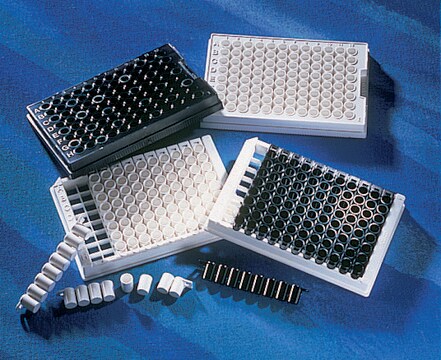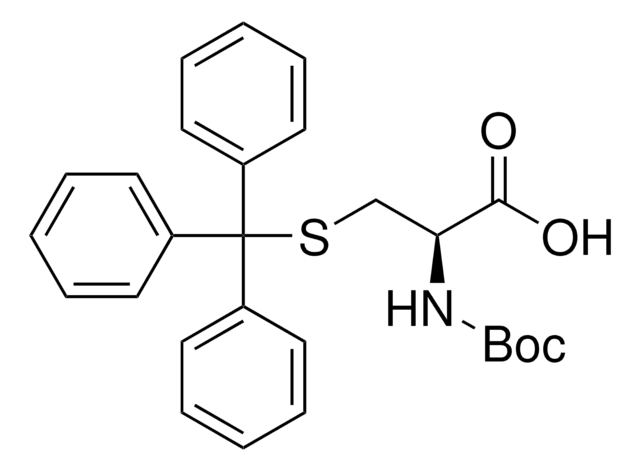P0194
Protein Kinase Cζ isozyme human
≥75% (SDS-PAGE), recombinant, expressed in baculovirus infected insect cells, buffered aqueous solution
Synonym(s):
Ca2+-activated phospholipid-dependent serine-threonine kinase ζ isozyme human, PKCζ human
Sign Into View Organizational & Contract Pricing
All Photos(1)
About This Item
Recommended Products
recombinant
expressed in baculovirus infected insect cells
Quality Level
Assay
≥75% (SDS-PAGE)
form
buffered aqueous solution
enzyme activity
>800 units/mg protein
mol wt
76-80 kDa by SDS-PAGE
UniProt accession no.
shipped in
dry ice
storage temp.
−70°C
Gene Information
human ... PRKCZ(5590)
Biochem/physiol Actions
Protein Kinase C (PKC) is a serine/threonine kinase that is activated intracellularly by signal transduction pathways that produce DAG from phosphatidylinositol diphosphate (PIP2) and phosphatidylcholine (PC) through the action of various activated phospholipases. Phorbol esters also stimulate PKC. At least 11 PKC isozymes have been identified that differ in primary structure, tissue distribution, subcellular localization, response to extracellular signals, and substrate specificity. The isozymes can be grouped into three subfamilies. Members of the first family require Ca2+ and phospholipid and include PKCα, βI, βII, and γ. Members of the second family are phospholipid-dependent but Ca2+-independent, and include PKCδ, ε, η, and θ. Members of the third family are not activated by either DAG or phorbol esters and include PKCξ, μ, and ι.
Phosphorylation appears to be an important mechanism of regulation of all PKCs. PKC plays a role in the regulation of cell transformation, growth, differentiation, ruffling, vesicle trafficking, apoptosis and gene expression.
Phosphorylation appears to be an important mechanism of regulation of all PKCs. PKC plays a role in the regulation of cell transformation, growth, differentiation, ruffling, vesicle trafficking, apoptosis and gene expression.
Suitability
PKC ε can transfer 1100 nmole of phosphate to PKC ε substrate peptide per minute per mg of total protein at 30 °C.
Unit Definition
One unit will transfer 1 nanomole of phosphate to PKC epsilon substrate peptide per minute at pH 7.5 at 30 deg C.
Physical form
Solution in 20 mM HEPES, pH 7.5; 2 mM EDTA, 2 mM EGTA, 5 mM DTT, 250 mM NaCl, 0.05% Triton X-100, and 50% glycerol.
Storage Class Code
10 - Combustible liquids
WGK
WGK 1
Flash Point(F)
Not applicable
Flash Point(C)
Not applicable
Personal Protective Equipment
dust mask type N95 (US), Eyeshields, Gloves
Choose from one of the most recent versions:
Already Own This Product?
Find documentation for the products that you have recently purchased in the Document Library.
Hai Huang et al.
Development (Cambridge, England), 138(12), 2477-2485 (2011-05-13)
Post-translational modification by the small ubiquitin-related modifier (SUMO) is important for a variety of cellular and developmental processes. However, the precise mechanism(s) that connects sumoylation to specific developmental signaling pathways remains relatively less clear. Here, we show that Smt3 knockdown
Jun Hou et al.
Journal of thoracic oncology : official publication of the International Association for the Study of Lung Cancer, 7(1), 105-114 (2011-12-03)
A challenge of cancer therapy is to optimize therapeutical options to individual patients. Cancers with similar histology may show dramatically different responses to therapy, indicating that a refined approach needs to be developed to classify tumors by intrinsic characteristics that
Sung Chul Lee et al.
Proceedings of the National Academy of Sciences of the United States of America, 104(40), 15959-15964 (2007-09-28)
Potassium (K(+)) is an essential nutrient for plant growth and development. Plants often adapt to low K(+) conditions by increasing their K(+) uptake capability. Recent studies have led to the identification of a calcium signaling pathway that enables plants to
Yong Xiang et al.
Plant physiology, 144(3), 1416-1428 (2007-05-31)
Plants respond to adverse environments by initiating a series of signaling processes that often involves diverse protein kinases, including calcineurin B-like protein-interacting protein kinases (CIPKs). In this study, putative CIPK genes (OsCIPK01-OsCIPK30) in the rice (Oryza sativa) genome were surveyed
Cecilia D'Angelo et al.
The Plant journal : for cell and molecular biology, 48(6), 857-872 (2006-11-10)
Intracellular release of calcium ions belongs to the earliest events in cellular stress perception. The molecular mechanisms integrating signals from different environmental cues and translating them into an optimized response are largely unknown. We report here the functional characterization of
Our team of scientists has experience in all areas of research including Life Science, Material Science, Chemical Synthesis, Chromatography, Analytical and many others.
Contact Technical Service






